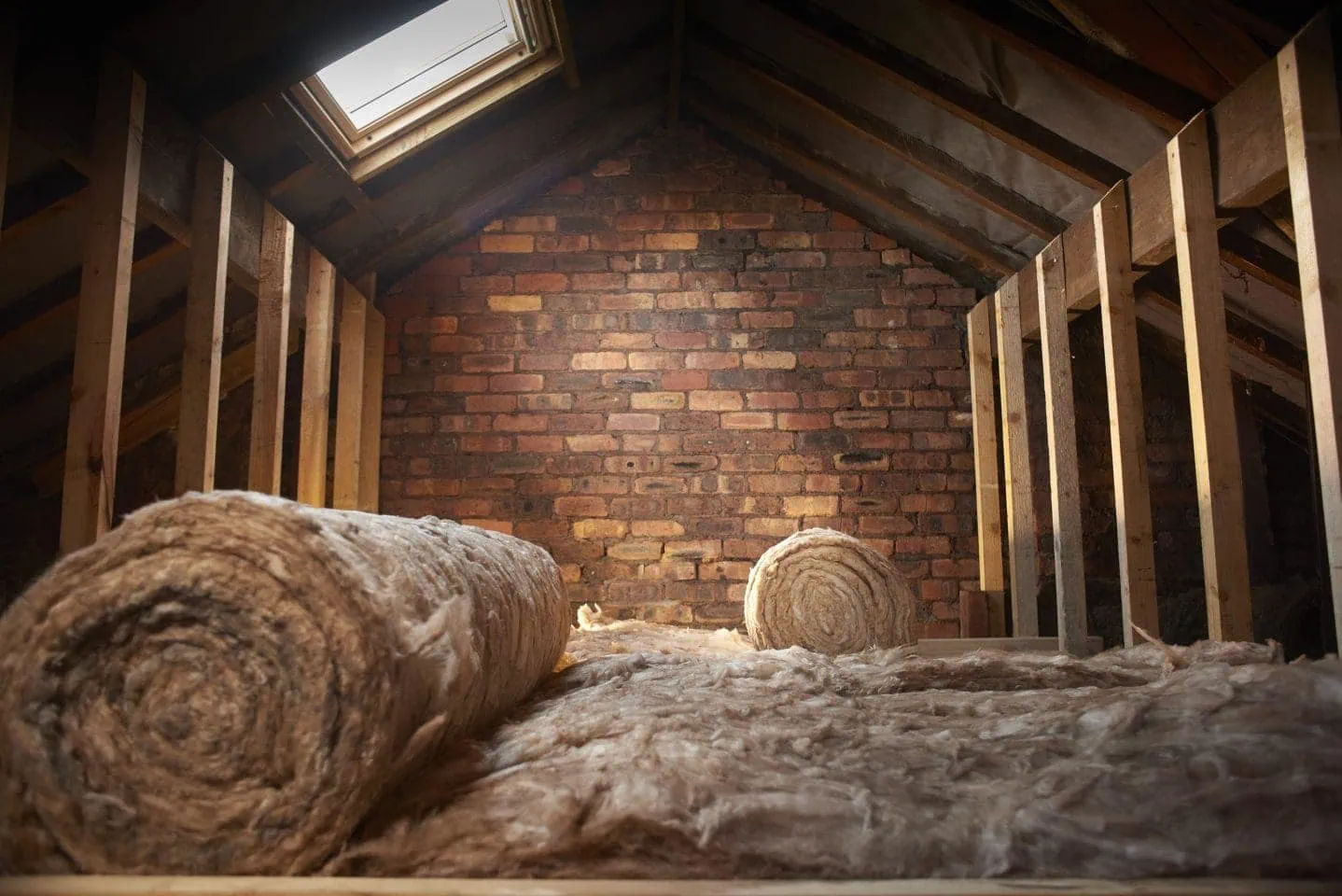Upgrading loft insulation: How much loft insulation do I need?
The government has plans to increase the minimum Energy Performance Certificate (EPC) rating in the coming years to make homes in the U.K. more energy efficient. This means that it’s a good idea to consider making home improvements to help boost your rating. Your loft insulation is a great place to start.
Installed correctly, a well-insulated loft can improve your home’s EPC rating. This can make it more appealing to buyers. Additionally, it has the potential to increase its value by 14%. Uninsulated lofts can cause 25% of heat loss in your home, leading to higher heating bills.
Installing loft insulation is also a great way to cut costs on your energy bills. According to the Energy Saving Trust, good quality loft insulation can save you up to £395 per year on energy bills.

Uninsulated lofts can cause 25% of heat loss in your home, leading to higher heating bills. Even if you have some sort of insulation already in place, it’s nevertheless a good idea to consider upgrading your loft insulation. Many homes in the U.K. do not have energy efficient loft insulation that complies with Building Regulations.
How do you know if you should upgrade your loft insulation? And do you need a professional to install it? To make things easier, our roofing team has created this guide with advice on what you should consider when looking to upgrade your loft insulation.
N.B. This guide explains the different options for loft insulation in pitched roofs. If you have a flat roof, certain advice and regulations will differ. Loft conversions also have separate regulations to follow.
Types of loft insulation
Loft insulation is available in a variety of forms, each of which are installed using various materials. Types of loft insulation include:
- Blanket insulation: the cheapest form of insulation most popular with DIYers. Blanket insulation usually comes as insulation rolls and slabs of mineral “wool” or sheep’s wool.
- Loose-fill insulation: made from materials like cork, mineral fibre, or cellulose fibre. The materials come in the form of lightweight granules that are poured between joists for a loose fill. This can be used on its own or to top up other types of insulation.
- Blown-fibre insulation: this is where a professional uses a machine to insulate hard-to-reach areas of a loft with loose materials. It is not used to insulate an entire loft. Blown-fibre insulation can also be used to top up existing insulation.
- Insulation boards/sheet insulation: often these are rigid insulation boards made from Polyisocyanurate (PIR) or Polyurethane (PUR), they have an excellent thermal efficiency, and give a high level of insulation at a reduced thickness in comparison to other methods of insulation. They are more expensive than other methods, but deliver highly effective insulation and are ideal to use when insulating the underside of your roof covering i.e. between rafters and on top of the joists.
- Foil insulation: layers of reflective foil and insulation material. Foil or multi-foil is one of the thinnest types of insulation you can get. Foil insulation is a good green option and is usually made with recycled materials. It is an expensive option, but is very lightweight and easy to install.
- Sprayed foam: while a cheap option, we recommend being cautious if using this method of insulation. This is where a layer of insulation is usually sprayed directly onto the back of a roof covering as a quick solution. It’s a liquid that solidifies, which means that it becomes very airtight and can be at risk of not leaving enough airflow for proper ventilation. More on this later.
How much loft insulation do I need?
Answering this question is difficult because it depends on the type and location of the insulation in the loft.
For example: thinner, more expensive types of insulation like multi-foil do not need to be laid as thick as other types to achieve a high level of insulation.
When people ask “how much loft insulation do I need?” It’s usually because they’re thinking about more traditional types of loft insulation, which is blanket insulation.
For these types, the government recommended loft insulation thickness is between 250mm and 270mm, although many properties now increase their level to 300mm. This is not relevant for all types of insulation.
Warm versus cold loft
With pitched roofs, there are a few options:
- Insulation between the ceiling joists i.e. on the loft floor: this prevents heat in your home from rising from the rooms below and heating the loft, and creates what is known as a “cold loft”.
- Insulation between the roof rafters: this minimises heat escaping from the loft space through the roof covering. This method creates a “warm loft” as heat from the house rises to heat the loft space.
- Insulation between both the ceiling joists and the roof rafters: this is the best option for optimal insulation.
Tip: Insulating between the roof rafters is usually a more expensive option, often requiring professional installation because it’s difficult to do as a DIY job. However, it’s definitely worth considering for a more energy efficient job.
Roof ventilation is essential!
People often ask “how much insulation do I need?” without also considering “how much ventilation will I need?”
It’s vital that your loft has the correct amount of ventilation to allow air flow. Not having enough ventilation in your loft can result in condensation, which can then lead to damp.
It’s important that your loft has sufficient ventilation to comply with modern Building Regulations. Any changes made to your loft space, including adding insulation, will change the amount of ventilation needed.
There are different types of ventilation, and you will need to have more than one type in your loft. This is because a cross flow of air needs to be able to circulate. Popular types of ventilation include: through soffits vents, ridge vents, tile vents and eave vents.
The amount of ventilation required for your loft will depend on its type and size. To determine how much ventilation you need, check out Building Regulation Approved Document C2 BS 5250. We have expert roofers who are happy to assess your existing ventilation and give advice on changes needed based on changes to insulation.
Advice from our expert:
‘In my experience, the most important consideration when insulating your loft is to ensure you also have the correct ventilation in place. Not ventilating correctly can cause condensation issues within the loft space. In extreme cases, I’ve seen roof timbers rotting as a result of damp, meaning the structural integrity of the roof is compromised. This invariably leads to hefty repair bills.’
-Lee Merryweather, Aspect Trade Manager, Roofing
For your peace of mind, it’s probably best to book a professional roofer to carry out any loft insulation work, or at least advise you before you start a DIY project.
A certified professional will guarantee that your loft is properly ventilated to comply with Building Regulations and also prevent condensation build-up.
Ready to upgrade your loft insulation?
Perhaps you have a few questions you’d like some professional advice on. We’re here to help! We’re available 24/7 to provide expert knowledge on all things loft insulation.
Thinking of upgrading your loft insulation? Book a roofer online and save 10% on labour charges.
Thinking of upgrading your loft insulation?

Our roofing experts are on hand for upgrading your loft insulation.
- Half-hourly rates from £42.75 + VAT
- One hour minimum
- £10 off when you book online
- Fixed pricing for planned work
Areas we cover

We have expert roofers who cover the whole of Greater London and the South East of England.
We can schedule any type of roofing work in Berkshire, Buckinghamshire, Cambridgeshire, East Sussex, Essex, Greater London, Hertfordshire, Kent, Surrey, and West Sussex.
If you are outside of this coverage area, we may still be able to assist you. Our scheduling team will check availability for your location. Call or submit a callback request, and a member of our team will be in touch with you.
Was this article helpful?
Think we could improve this article? Please let us know